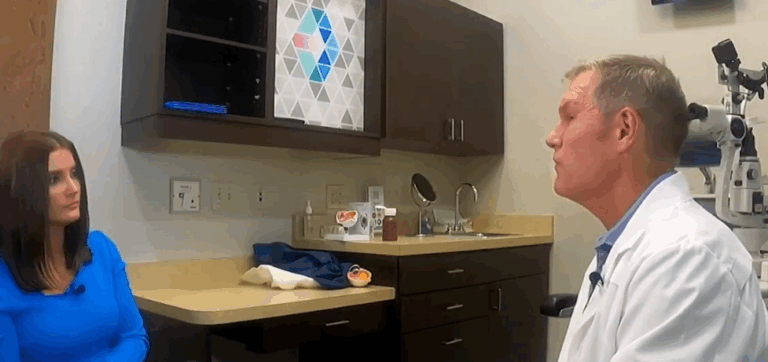Robin Kyle Reeves led what many would consider a tranquil, contented life until recently. Because she designed delicate lace gowns for family portraits and baptisms, she had to be extremely precise—every thread counted. She chose to have LASIK eye surgery because her glasses frequently got in the way. The “quick fix” she had been promised was radically different from what transpired next.
Reeves had LASIK surgery on July 12, 2022. The process was advertised as “zip-zap”—a fast adjustment that produced results almost instantly. Rather, she experienced a series of adverse effects that significantly changed her daily functioning. She currently suffers from excruciating migraines, lingering double vision, and debris under the corneal flap that permanently blurred her vision. Even though the surgery seemed routine, it was particularly upsetting how unprepared she felt for these outcomes.
The risks appear to mount more quickly and pierce deeper for women like Reeves. According to medical data, up to 70% of LASIK patients experience dry eye syndrome; however, women are noticeably more vulnerable, particularly those who are nearing menopause. Although it can last forever, this condition usually peaks in the first three months after surgery. The extreme dryness in Reeves’s case has only made it more difficult for her to recover, exacerbating other issues.
Patient Profile – Robin Kyle Reeves (LASIK Eye Surgery Case)
| Detail | Information |
|---|---|
| Full Name | Robin Kyle Reeves |
| Profession | Children’s Garment Designer |
| Location | Laurel Hill, Florida, USA |
| Procedure Type | LASIK Eye Surgery |
| Date of Procedure | July 12, 2022 |
| Reported Complications | Double vision, corneal flap debris, chronic migraines |
| Gender-Specific Risk Factors | Higher susceptibility to dry eyes, hormonal impact near menopause |
| Age-Related Risk Factors | Increased vulnerability to vision changes and slower corneal healing |
| Medical Advisory Source | Dayal Eye Centre – https://dayaleyecentre.in/blog/what-is-the-dark-side-of-lasik-eye-surgery/ |
| Industry Concern | Underreported long-term side effects in female patients, particularly dry eyes and corneal ectasia |

It’s interesting to note that a median of 0.6% of LASIK patients lost lines on their eye chart after surgery, according to a previous report from the National Institute for Health and Clinical Excellence (NICE). Even though this might seem insignificant, the number becomes much more alarming when considering the millions of procedures that are performed each year. Warnings about the long-term consequences of LASIK, including glare, double vision, difficulty driving at night, and in severe cases, irreversible vision loss, have even been published by the U.S. FDA. These results have been remarkably similar and persistently unaddressed for many women.
A few celebrities have also talked about their post-LASIK discomfort. Although she hasn’t openly opposed the procedure, actress Brooke Shields has long discussed her struggles with dry eyes. The coincidence is hard to overlook, even though it was never formally ascribed to LASIK. The pressure to have such procedures is evident in a field where convenience is paramount and appearance is crucial, particularly for women who are subjected to more severe criticism for their physical flaws.
A more comprehensive picture of society is revealed by contrasting the widespread use of LASIK with the silent lament of those who experience side effects. In order to avoid long-term problems like persistent dryness or permanent halos around lights, many women choose LASIK in the hopes of being free of glasses or contact lenses. Although men can experience complications as well, research has consistently shown that women’s hormonal changes, particularly during perimenopause, greatly raise the risk of negative consequences.
For example, up to 15% of surgeries result in complications from corneal flaps. Simple movements like rubbing one’s eyes or squeezing one’s eyelids can cause the flap to move. Women may be more susceptible to these dislocations, particularly if they have smaller orbital spaces or thinner corneas. The effects go beyond appearances; they interfere with sleep, self-esteem, and the very things that used to make you happy.
The cost goes beyond the initial surgery from an economic perspective. Insurance rarely covers LASIK. Follow-up appointments, dry eye treatments, special eye drops, and occasionally repeat surgeries are among the hidden expenses. These ongoing expenses have put a real financial burden on Reeves. It turns out that seeing clearly comes at a surprisingly high cost, and that cost is frequently constant.
Over time, vision changes can also be a hidden burden. After a few years, about 5% of LASIK patients experience changing vision. For those who were more nearsighted prior to the surgery, this is noticeably worse. Consider it a gradual disintegration of the “permanent solution” that was promised to them. Approximately 35% of patients need retreatment over a ten-year period. The disappointment is particularly severe for women who were hoping for a one-time change.
The LASIK procedure is still being glamorized by the media. In eye clinics, young, active women are shown grinning after a quick procedure. However, they hardly ever depict the nights those women spend adjusting to halos that never quite go away or applying artificial tears every hour. The emotional and physical exhaustion that many actual patients go through is not reflected in that narrative, which is remarkably well-written.
Although LASIK is remarkably effective in certain cases, there are currently no long-term tracking protocols, particularly for female patients. The gender gap in complication data has not yet been fully addressed by the medical community, despite the fact that advancements have made lasers smarter and recovery faster. Research on women’s health issues is still lacking, and this is also true of eye surgery. Clinics run the risk of causing silent suffering for thousands of people like Reeves if they don’t research these subtleties.
When we take into account that more women than men seek cosmetic enhancements, the wider impact becomes especially evident. LASIK is now one of the procedures that, although initially promising confidence, can sometimes result in chronic management. The focus needs to change from perfect marketing to complete transparency.
Institutions of public health are beginning to pay attention. Long-term auditing, surgeon accountability, and more thorough patient education have all been suggested by the NICE guidelines. Patients like Reeves, however, continue to live in a medical gray area until these changes are widely implemented because they take time. Even though laser surgery is incredibly flexible, it isn’t universally applicable and isn’t risk-free.
The healthcare sector has a chance to move toward greater honesty by refocusing the discussion on lived experience, particularly among women. Although LASIK is not the enemy, keeping quiet about its dangers is. There should be a very clear road map for each patient looking to improve their vision, complete with expectations, odds, and compassionate treatment.
Clinics may reconsider how they counsel patients if they realize that vision is a deeply emotional function in addition to a biological one. A woman who loses her vision isn’t just getting used to wearing new glasses; she’s also changing the way she views herself. And that’s worth more than a two-minute consultation or a pamphlet.
Making educated decisions becomes even more crucial as the demand for LASIK stays consistent, particularly among working mothers and professionals who are juggling many responsibilities. What works incredibly well for one person might change someone else’s life. We open the door to safer outcomes and greater confidence in medicine by promoting more in-depth discussions, funding studies on gender-specific issues, and elevating voices like Robin Kyle Reeves.


